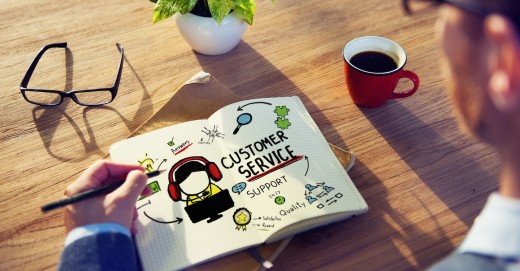
There’s never a dull moment when you’re a customer service manager. Not only do you need to help customers and increase satisfaction, but you also need to study, evaluate, and restructure support processes to continually improve l performance. You may also be responsible for a team of customer service specialists and representatives. It’s a big responsibility, being in charge of the friendly face and helping hand that make your company personable.
Sounds exhausting right? Luckily, there are lots of tools of the trade to help you out. . Suddenly management just got, well, a little more manageable.
-
Add Automated Surveys
As a manager, you are not there to listen to every conversation with a customer or breathe down the necks of your employees. But, you do need to ensure your reps have the best service skills because their performance reflects directly back to you and on the company.
Implementing customer feedback surveys in a non-obtrusive way encourages customers to complete them honestly and fully. While customer satisfaction surveys are nothing new—they are one of the best ways to get data—it’s important to implement them correctly.

It’s easy to use GetFeedback or SurveyMonkey to implement a branded digital survey, absent of bias, at the point of sale, in a post-sale receipt email, or in a post issue-resolving conversation. If your product or service is in-person, offer a takeaway that directs to the digital feedback survey. The goal is to gain intelligence.
-
Incentivize the Troops
Happy, engaged, motivated employees are, well, the kind of people your customers are going to want to talk to. They’re the kind of people you want to work with! There are intrinsic motivators that come with a paycheck, such as belief in the mission, and personal satisfaction, and then there are extrinsic motivators such as incentives.
This is something you, as the customer service manager, can influence. Remember that the best incentives are strategically planned and tied to specific, realistic goals. It’s also important that customer service agents have a voice in deciding the incentives.
Incentives can break free of the chains of gift cards or extra cash; many employees are searching for career advancement so the incentive of extra time off to pursue additional training and education can be very powerful.
Whatever realistic goals are set to reach the incentive markers, be sure the actions to meet those goals are logged honestly and incentives are dispersed on time with a bit of public admiration to encourage others.
-
Seize the Day with Social Media
Social media has changed the way that consumers interact with brands. It is easier than ever for customers to leave reviews, issue complaints and offer public-facing critique on both the product/service and the customer service. Whether your company is big or small, you need to pay attention. And, with the right customer service software and helpdesk tools, you can streamline your social media processes.

Churn rate (customers leaving) can increase 15 percent when companies fail to respond on social media channels.
If some of a brand’s social media responsibilities live within the customer service department, it’s important to invest in a tool that will help you respond to inquiries,, run reports, and analyze social sentiment and reach. You can aggregate networks—Facebook, Twitter, Instagram, SnapChat, YouTube—in an easy to operate platform.
Look for a full service tool that offers scheduling (to optimize time management), analytics (to review efforts), sentiment trackers (to evaluate audience perception and prepare customer service accordingly) and keyword tools (to review trends in reviews and statements). The more you can automate this process the more time you will have time to deliver timely, impactful service through social media.
-
Enable Fluid Channel Switching
If your company has the budget, go above and beyond classic social media monitoring for exceptional customer support. Integrate social media with your customer service software so you know customers wherever you meet them. This is becoming more and more a customer request as 43 percent of customers expect other customer service channels—email, web chat, voice call—to be integrated with social media channels. Make your life easier by doing the work up front to better meet customer expectations.
Certain tools let customer service reps direct customers through a seamless chain to offer better assistance outside the limitations of character counts and account information privacy from the original social media platform.
Using social customer service platforms can result in deeper engagements with customers and a reduced cost across marketing, sales and the customer service department as they are united and communication about a similar tool. Social support can also reduce time spent measuring analytics across platforms, as the software will pull the top markers for your goals.
-
Help Yourself by Letting Customers Help Themselves
One of the best ways to reduce support volume is by introducing self-service support and giving a nudge toward the portal so they can address their question or issue in the least amount of time and with the best quality information. Help your customers help themselves. This is just another way of providing excellent communication and service, outside of the traditional phone call.

40 percent of consumers (3,000 were surveyed globally) said they prefer self-service to humans for customer service; 70 percent expect company websites to include a self-service portal.
This doesn’t eliminate the need for numbers on the frontline, as phones still account for 68 percent of contact center communications. It just lets your customers gain knowledge and easily solve common problems, so they can move on happily, and you can focus on more complex issues.
-
Hire with Heart
If one of your customer service reps has never worked in the industry before, that’s fine. Sometimes that’s even better because you can train them with the high levels of values you hold dear. But, the one thing you have to ensure in new hires is that they have the essence of customer service in their hearts and heads—they like to please people, fix problems, and mediate future issues. You can train people to use a customer support system or answer a phone well, but you can’t manufacture the desire to help people.
How can you tell the amazing hires from the rest? Consider asking interviewees to step into the shoes of the customer. If they were to write a review on a site like Yelp what would the perfect experience look like? What would they want to occur to come away with a sense of solvency and positivity affinity for the company? Responses that focus on key attributes of an excellent customer service representative—patience, clear communication, attentiveness to the employee and the issue at hand.
-
Make Customers’ Lives Easy Too
Customer service managers should add the Customer Effort Score (CES) to the main metrics they are tracking. What is the CES? Basically how much effort does the customer have to put in to have a request handled? On a scale from 1 (very low effort) to 5 (very high effort) the customer service team wants to keep this number as low as possible.
The higher the amount of effort a consumer puts into a request, the more likely they are to shift their business elsewhere and speak negatively about the company—the easier the better. Predictions for successful continued business are parallel to low effort with high percentages of people indicating intent to repurchase and actually increase in spending with the business.

59 percent of customers report moderate-to-high effort to resolve an request. By making what is expected to be easy actually easy, you can rise above the two-thirds of customer service experiences that require a lot of effort.
Look at Gourmet Ads, an online platform that manages advertising for 1,200+ food websites, which integrated customer support content into its product. Customers can find help in-context, without having to leave the Gourmet Ads experience. The result? An 80% reduction in drop off rates.
8. Engage Proactively
The days when your agents clocked in and waited for calls and emails from customers are long gone. We’re increasingly seeing connected products and wearables that initiate their own service tickets. In the future companies will know when customers are having trouble and can reach out before they even have a chance to pick up the phone, and sometimes before they even know there’s an issue.
Today, some small companies are already doing it. Bitium, which provides single-sign on technology, can tell when users are having trouble logging in. Instead of waiting for the customer to call, the company will proactively reach out to help.
Read Next: Entrepreneurs’ secrets: business leaders share insights you’d never glean from a seminar
Image credit: Shutterstock
Get the TNW newsletter
Get the most important tech news in your inbox each week.
T his post was brought to you by desk.com the fast, awesome customer service app for small business.
his post was brought to you by desk.com the fast, awesome customer service app for small business.





